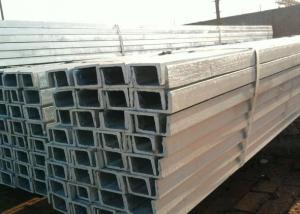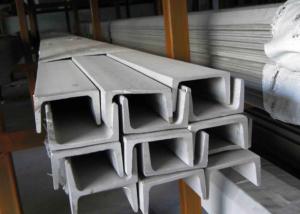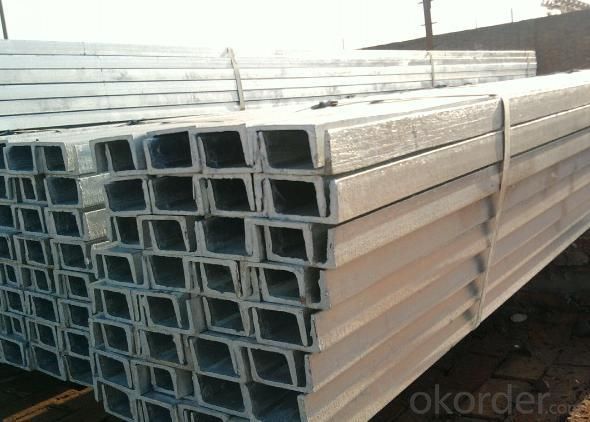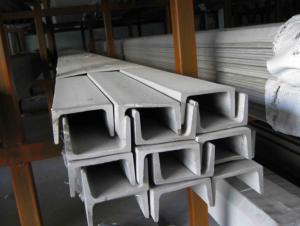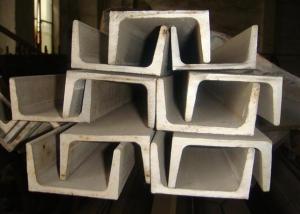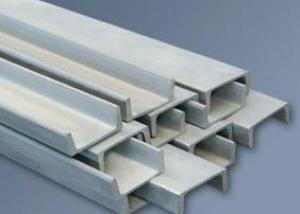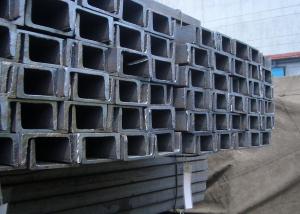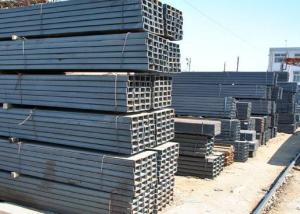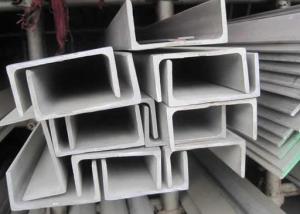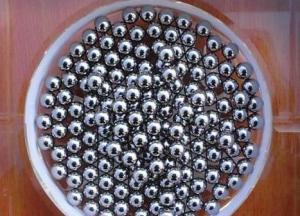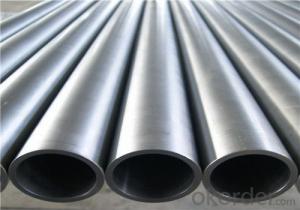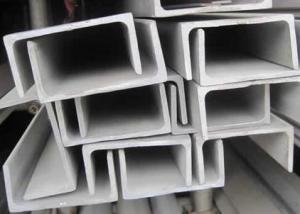316L Stainless Steel Channels-SUM,316L
- Loading Port:
- China Main Port
- Payment Terms:
- TT or LC
- Min Order Qty:
- 5 Tons m.t.
- Supply Capability:
- 1000 Tons Per Month m.t./month
OKorder Service Pledge
OKorder Financial Service
You Might Also Like
Stainless Steel Channel
1.Size: 3mm to 24mm Thickness
2.Material:SUS201,202,301,304,304L,316,316L ,321 etc.
3.Length: 4m to 6m,or according to the customer's requirement
4.Standard: AISI,JIS,GB,DIN
5.Finish: Cold Drawn ,hot rolled & Polishing
6.Testing: Each heat number and batch must be tested for both chemical and mechanical properties
7.Application: Produce screw and nut, engine parts, indoor and outdoor decorating,etc.
|
Size (mm) |
Thickness (mm) | ||||||||
|
H×B |
3 |
4 |
5 |
6 |
7 |
8 |
9 |
10 |
12 |
|
Mass (Kg/m) | |||||||||
|
40×20 |
1.79 |
|
|
|
|
|
|
|
|
|
50×25 |
2.27 |
|
|
|
|
|
|
|
|
|
60×30 |
2.74 |
3.56 |
4.37 |
5.12 |
|
|
|
|
|
|
70×35 |
3.23 |
4.21 |
5.17 |
6.08 |
|
|
|
|
|
|
80×40 |
3.71 |
4.84 |
5.96 |
7.03 |
|
|
|
|
|
|
90×45 |
4.25 |
5.55 |
6.83 |
8.05 |
|
|
|
|
|
|
100×50 |
4.73 |
6.18 |
7.62 |
8.98 |
10.3 |
11.7 |
13 |
41.2 |
|
|
120×60 |
|
|
9.2 |
10.9 |
12.6 |
14.2 |
|
|
|
|
130×65 |
|
|
10.1 |
11.9 |
13.8 |
15.5 |
17.3 |
19.1 |
|
|
140×70 |
|
|
|
12.9 |
14.9 |
16.8 |
18.8 |
20.7 |
|
|
150×75 |
|
|
|
13.9 |
16 |
18.1 |
20.2 |
22.2 |
26.3 |
|
160×80 |
|
|
|
14.8 |
17.1 |
19.3 |
21.6 |
23.8 |
28.1 |
|
180×90 |
|
|
|
16.7 |
19.4 |
22 |
24.5 |
27 |
32 |
|
200×100 |
|
|
|
18.6 |
21.6 |
24.5 |
27.4 |
30.2 |
35.8 |

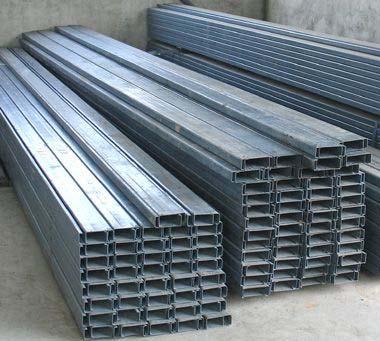
- Q: What are the different installation techniques for stainless steel channels?
- There are several installation techniques for stainless steel channels, including adhesive bonding, mechanically fastening, and welding. Adhesive bonding involves using a strong adhesive to secure the channel in place, while mechanically fastening involves using screws or bolts to attach the channel to the desired surface. Welding is another technique where the channel is fused to the surface using heat. The choice of installation technique depends on factors such as the application, load requirements, and aesthetic preferences.
- Q: Can stainless steel channels be used for framing partitions?
- Yes, stainless steel channels can be used for framing partitions. Stainless steel channels are durable, corrosion-resistant, and have excellent strength properties, making them suitable for various structural applications, including framing partitions. They provide stability and support to the partition walls, ensuring longevity and structural integrity.
- Q: Can stainless steel channels be used for framing partitions or walls?
- Yes, stainless steel channels can be used for framing partitions or walls. Stainless steel is a durable and sturdy material that can provide structural support and stability to walls or partitions. It is resistant to corrosion, making it suitable for both indoor and outdoor applications. Additionally, stainless steel channels offer versatility in design and can be easily customized to meet specific project requirements.
- Q: What are the different grades of stainless steel used for channels?
- Stainless steel channels are commonly used in various industries for their durability, strength, and corrosion resistance. There are different grades of stainless steel available, each with its own unique properties and applications. The most commonly used grades of stainless steel for channels are 304 and 316. 304 stainless steel is a versatile and widely used grade that offers good corrosion resistance and excellent formability. It is commonly used in construction, architectural, and industrial applications where strength and aesthetics are important. It is also suitable for food processing and storage equipment due to its resistance to corrosion from most organic and inorganic chemicals. 316 stainless steel is a higher-grade alloy that contains molybdenum, which enhances its corrosion resistance, particularly against chlorides and other chemicals. It is commonly used in marine environments, such as boat fittings and offshore structures, as well as in industries that require resistance to harsh chemicals, such as the pharmaceutical and chemical industries. Other grades of stainless steel that may be used for channels include 304L, 316L, and duplex stainless steels such as 2205. 304L is a low-carbon variant of 304, which provides improved weldability and resistance to sensitization (a type of corrosion that can occur in certain environments). It is commonly used in applications where welding is required, such as in the fabrication of channels. 316L is the low-carbon version of 316, offering similar corrosion resistance and improved weldability. It is commonly used in industries where weldability and corrosion resistance are critical, such as in the production of pharmaceutical and medical equipment. Duplex stainless steels, such as 2205, offer a combination of high strength and corrosion resistance. They are commonly used in applications where both properties are important, such as in the oil and gas industry, chemical processing plants, and marine environments. Overall, the grade of stainless steel used for channels depends on the specific requirements of the application, including the level of corrosion resistance, strength, and weldability needed. Proper selection of the grade ensures the longevity and performance of stainless steel channels in various environments.
- Q: Are stainless steel channels suitable for pharmaceutical or cleanroom applications?
- Yes, stainless steel channels are suitable for pharmaceutical or cleanroom applications. Stainless steel is highly resistant to corrosion, easy to clean, and has a smooth surface that minimizes the risk of contamination. It is also durable and can withstand the stringent requirements of pharmaceutical and cleanroom environments.
- Q: What are the different load-carrying capacities of stainless steel channels?
- The load-carrying capacities of stainless steel channels vary depending on their dimensions, thickness, and material grade. It is important to consult engineering resources or manufacturers' specifications to determine the specific load-carrying capacities for different stainless steel channel sizes and configurations.
- Q: How do stainless steel channels perform in terms of thermal insulation or energy efficiency?
- Stainless steel channels, as a construction material, generally do not possess high thermal insulation properties or demonstrate exceptional energy efficiency. Stainless steel is known for its excellent strength, durability, and corrosion resistance, making it a popular choice for various applications in the construction industry. However, it is not an effective insulator of heat or cold. Stainless steel has a relatively high thermal conductivity compared to other materials used for thermal insulation, such as insulation foams or fiberglass. This means that it allows heat to transfer more easily through its structure, resulting in poor thermal insulation performance. As a result, stainless steel channels may not be the best choice if the primary goal is to achieve high thermal insulation or energy efficiency in a building or structure. To enhance thermal insulation or energy efficiency in a construction project, additional measures need to be taken. This could involve incorporating insulation materials like mineral wool, foam panels, or other specialized insulation products. These materials can be used alongside stainless steel channels to create a more energy-efficient system. Additionally, proper sealing and insulation techniques, such as double-glazed windows or insulated doors, can further improve the overall thermal performance of a building. In summary, while stainless steel channels offer several advantages in terms of strength and durability, they do not provide significant thermal insulation or energy efficiency. To achieve optimal thermal insulation or energy efficiency in a construction project, it is important to consider the use of additional insulation materials and techniques alongside stainless steel channels.
- Q: Are stainless steel channels suitable for hygienic or sterile applications, such as hospitals?
- Stainless steel channels prove to be an excellent option for maintaining hygiene and sterility, particularly in hospitals. Thanks to its non-porous nature and resistance to corrosion, stainless steel is easy to clean and ensures proper hygiene standards are upheld. Furthermore, its durability and strength guarantee long-term reliability even in demanding hospital environments. The ability of stainless steel channels to be easily sanitized and resist bacterial growth makes them perfect for use in crucial areas such as operating rooms, laboratories, and cleanrooms where cleanliness and sterility are paramount. Additionally, stainless steel boasts low levels of allergenic properties, reducing the risk of allergic reactions or sensitivities in sensitive environments. All in all, the various qualities of stainless steel render it a fitting choice for hygienic or sterile applications in hospitals and other healthcare facilities.
- Q: How do you specify stainless steel channels for a project?
- When specifying stainless steel channels for a project, there are several factors to consider to ensure the desired results. Here is a step-by-step guide on how to specify stainless steel channels effectively: 1. Determine the grade of stainless steel: Stainless steel is available in various grades, each with its own unique properties and applications. Consider factors such as corrosion resistance, strength, and temperature resistance to select the appropriate grade for your project. 2. Calculate the dimensions: Specify the required dimensions of the stainless steel channels, including the height, width, and thickness. These dimensions will depend on the intended use and load-bearing requirements of the channels. 3. Decide on the channel type: There are different types of stainless steel channels, such as C-channels, U-channels, and J-channels. Choose the type that best suits your project's needs and specifications. 4. Determine the finish: Stainless steel channels can be supplied with various finishes, including brushed, polished, or mill finishes. Consider the aesthetic requirements of your project and specify the appropriate finish accordingly. 5. Consider any additional requirements: If your project has specific requirements such as special tolerances, certifications (e.g., ASTM or ISO standards), or surface treatments, make sure to specify them. 6. Specify quantity and lengths: Determine the quantity of stainless steel channels needed for your project, and specify the required lengths. This will ensure accurate cost estimation and efficient production planning. 7. Consult with suppliers and manufacturers: Collaborate with stainless steel suppliers or manufacturers to ensure that your specifications align with the available options and production capabilities. They can provide valuable input and assist in selecting the right stainless steel channels for your project. 8. Document your specifications: Finally, clearly document all the specified requirements, dimensions, finishes, and any other details in your project documentation. This will help avoid any miscommunication and ensure that your stainless steel channels are produced accurately according to your specifications. By following these steps and collaborating with experienced suppliers or manufacturers, you can effectively specify stainless steel channels that meet your project's requirements and achieve the desired outcome.
- Q: What is the cost of stainless steel channels compared to other materials?
- The cost of stainless steel channels is generally higher compared to other materials due to its durability, corrosion resistance, and aesthetic appeal.
1. Manufacturer Overview
| Location | Jiangsu, China |
| Year Established | 2010 |
| Annual Output Value | above US$8 million |
| Main Markets | East Asia, Middle East, West Europe |
| Company Certifications |
2. Manufacturer Certificates
| a) Certification Name | |
| Range | |
| Reference | |
| Validity Period |
3. Manufacturer Capability
| a) Trade Capacity | |
| Nearest Port | Shanghai |
| Export Percentage | |
| No.of Employees in Trade Department | above 50 people |
| Language Spoken: | English, Chinese, Arabic |
| b) Factory Information | |
| Factory Size: | about 15000 square meter |
| No. of Production Lines | above 4 |
| Contract Manufacturing | OEM Service Offered,Design Service Offered |
| Product Price Range | Average |
Send your message to us
316L Stainless Steel Channels-SUM,316L
- Loading Port:
- China Main Port
- Payment Terms:
- TT or LC
- Min Order Qty:
- 5 Tons m.t.
- Supply Capability:
- 1000 Tons Per Month m.t./month
OKorder Service Pledge
OKorder Financial Service
Similar products
Hot products
Hot Searches
Related keywords
